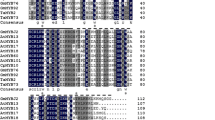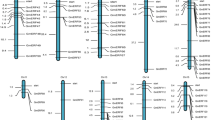Abstract
The zinc finger protein (ZFP) transcription factor family plays an important role in regulating plant growth, development, and response to abiotic stress. In this study, we aimed to determine the role of GmZAT4, a C2H2-type transcription factor, in abiotic stress tolerance. The complete coding sequence of the GmZAT4 gene was isolated from soybean root RNA, which shows highest expression level compared with leaf, flower and other tissues. Using multiple sequence alignment and conserved domain analysis, we showed that GmZAT4 is a typical C2H2-type transcription factor which is comprised of two C2H2 domains, including a highly conserved QALGGH motif, and implied the regulation of abiotic stress tolerance in plant. A phylogenetic tree revealed that the soybean GmZAT4 gene clustered with ZAT4 from Glycine soja and AZF1, AZF2, and AZF3 from Arabidopsis thaliana. The mRNA expression levels of GmZAT4 were determined in two soybean cultivars by quantitative reverse transcription (qRT)-PCR and compared. The results showed higher expression (up to 60, 25 and 4 times, respectively) in the drought-tolerant type (Jinda 74) compared to the drought-sensitive soybean cultivar (Jinda 53) following treatment with 18% PEG, 150 mM NaCl, or 100 µM abscisic acid (ABA). GmZAT4 was ectopically over-expressed in A. thaliana to determine its role in abiotic stress tolerance. GmZAT4 overexpression enhanced the tolerance of A. thaliana to treatment with 20% PEG and 150 mM NaCl, and improved the germination rate following treatment with 1 µM or 2 µM ABA. The expression profiles of marker genes in the ABA signaling pathway, such as RD29A, RD29B, ABI, and RAD, indicated that GmZAT4 enhanced the abiotic stress tolerance of Arabidopsis. These results suggest that the C2H2-type ZFP encoded by GmZAT4 plays an important role in PEG and NaCl stress tolerance and ABA responses in soybean and A. thaliana.





Similar content being viewed by others
References
Agarwal P, Arora R, Ray S, Singh AV, Takatsuji H, Kapoor S, Tyagi AK (2007) Genome-wide identification of C2H2 zinc-finger gene family in rice and their phylogeny and expression analysis. Plant Mol Biol 65(4):467–485
Ciftci-Yilmaz S, Mittler R (2008) The zinc finger network of plants. Cell Mol Life Sci 65:1150–1160
Clemente TE, Cahoon EB (2009) Soybean oil: genetic approaches for modification of functionality and total content. Plant Phys 151(3):1030–1040
Cutforth HW, Mcginn SM, Mcphee KE, Miller PR (2007) Adaptation of pulse crops to the changing climate of the northern great plains. Agron J 99(6):1684–1699
Englbrecht CC, Schoof H, Bohm S (2004) Conservation, diversification and expansion of C2H2 zinc finger proteins in the Arabidopsis thaliana genome. BMC Genom 5(1):39
Gao SQ, Chen M, Xu ZS, Zhao CP, Li L, Xu HJ, Tang YM, Zhao X, Ma YZ (2011) The soybean GmbZIP1 transcription factor enhances multiple abiotic stress tolerances in transgenic plants. Plant Mol Biol 75(6):537–553
Gharsallah C, Fakhfakh H, Grubb D, Gorsane F (2016) Effect of salt stress on ion concentration, proline content, antioxidant enzyme activities and gene expression in Tomato cultivars. AoB Plants 8:plw055
Hou SY, Sun ZX, Guo B, Wang YG, Li GQ, Han YH (2014) Cloning and expression analysis of two C2H2 transcription factors in soybean. Plant Physiol J 50(5):665–674
Hou SY, Sun ZX, Linghu B, Wang YG, Huang KS, Xu DM, Han YH (2015) Regeneration of buckwheat plantlets from hypocotyl and the influence of exogenous hormones on rutin content and rutin biosynthetic gene expression in vitro. Plant Cell Tissue Organ Cult 120(3):1159–1167
Huang J, Wang JF, Zhang HS (2004) Structure and function of plant C2H2 zinc finger protein. Yichuan 26(3):414–418
Huang F, Chi Y, Meng Q, Gai J, Yu D (2006) GmZFP1 encoding a single zinc finger protein is expressed with enhancement in reproductive organs and late seed development in soybean (Glycine max). Mol biol Rep 33(4):279–285
Huang GQ, Li W, Zhou W, Zhang JM, Li DD (2013) Seven cotton genes encoding putative NAC domain proteins are preferentially expressed in roots and in responses to abiotic stress during root development. Plant Growth Regul 71(2):101–112
Jin JP, Tian F, Yang DC, Meng YQ, Kong L, Luo JC, Gao G (2017) PlantTFDB 4.0: toward a central hub for transcription factors and regulatory interactions in plants. Nucleic Acids Res 45:1040–1045
Katiyar A, Smita S, Lenka SK, Rajwanshi R, Chinnusamy V, Bansal KC (2012) Genome-wide classification and expression analysis of MYB transcription factor families in rice and Arabidopsis. BMC Genom 13(1):544
Kodaira KS, Qin F, Tran LS, Maruyama K, Kidokoro S, Fujita Y, Shinozaki K, Yamaguchi-Shinozaki K (2011) Arabidopsis Cys2/His2 zinc-finger proteins AZF1 and AZF2 negatively regulate abscisic acid-repressive and auxin-inducible genes under abiotic stress conditions. Plant Physiol 157(2):742–756
Lata C, Prasad M (2011) Role of DREBs in regulation of abiotic stress responses in plants. J Exp Bot 62(14):4731–4738
Lee SC, Luan S (2012) ABA signal transduction at the crossroad of biotic and abiotic stress responses. Plant Cell Environ 35(1):53–60
Luo X, Bai X, Zhu D, Li Y, Ji W, Cai H, Wu J, Liu B, Zhu Y (2012a) GsZFP1, a new Cys2/His2-type zinc-finger protein, is a positive regulator of plant tolerance to cold and drought stress. Planta 235(6):1141–1155
Luo X, Cui N, Zhu Y, Cao L, Zhai H, Cai H, Ji W, Wang X, Zhu D, Li Y, Bai X (2012b) Over-expression of GsZFP1, an ABA-responsive C2H2-type zinc finger protein lacking a QALGGH motif, reduces ABA sensitivity and decreases stomata size. J Plant Physiol 169(12):1192–1202
Min SL, Gippert GP, Soman KV, Case DA, Wright PE (1989) Three-dimensional solution structure of a single zinc finger DNA-binding domain. Science 245(4918):635–637
Moore M, Ullman C (2003) Recent developments in the engineering of zinc finger proteins. Brief Funct Genom Protemic 1(4):342–355
Phang TH, Shao GH, Lam HM (2008) Salt tolerance in soybean. J Integr Plant Biol 50(10):1196–1212
Sakamoto H, Maruyama K, Sakuma Y, Meshi T, Iwabuchi M, Shinozaki K, Yamaguchi-Shinozaki K (2004) Arabidopsis Cys2/His2-type zinc-finger proteins function as transcription repressors under drought, cold, and high-salinity stress conditions. Plant Physiol 136(1):2734–2746
Takatsuji H (1999) Zinc-finger proteins: the classical zinc finger emerges in contemporary plant science. Plant Mol Biol 39(6):1073–1078
Tamura K, Stecher G, Peterson D, Filipski A, Kumar S (2013) MEGA6: molecular evolutionary genetics analysis version 6.0. Mol Biol Evol 30:2725–2729
Vives-Peris V, Marmaneu D, Gómez-Cadenas A, Pere-Clemente RM (2018) Characterization of Citrus, WRKY transcription factors and their responses to phytohormones and abiotic stresses. Biol Plant 62(1):33–44
Xiong L, Schumaker KS, Zhu JK (2002) Cell signaling during cold, drought, and salt stress. Plant Cell 14:165–183
Yu GH, Jiang LL, Ma XF, Xu ZS, Liu MM, Shan SG, Cheng XG (2014) A soybean C2H2-type zinc finger gene GmZF1 enhanced cold tolerance in transgenic Arabidopsis. PLoS One 9(10):e109399
Yu YH, Li XZ, Wu ZJ, Chen DX, Li GR, Li XQ, Zhang GH (2016) VvZFP11, a Cys2His2-type zinc finger transcription factor, is involved in defense responses in Vitis vinifera. Biol Plant 60(2):292–298
Zhang X, Henriques R, Lin SS, Niu QW, Chua NH (2006) Agrobacterium-mediated transformation of Arabidopsis thaliana using the floral dip method. Nat Protoc 1(2):641–646
Zhang H, Ni L, Liu Y, Wang Y, Zhang A, Tan M, Jiang M (2012) The C2H2-type zinc finger protein ZFP182 is involved in abscisic acid-induced antioxidant defense in rice. J Integr Plant Biol 54(7):500–510
Zhang DY, Tong JF, Xu ZL, Wei PP, Xu L, Wan Q, Huang YH, He XL, Yang JY, Shao HB, Ma HX (2016) Soybean C2H2-type zinc finger protein GmZFP3 with conserved QALGGH motif negatively regulates drought responses in transgenic arabidopsis. Front Plant Sci 7:325
Zhao Y, Chang X, Qi D, Dong L, Wang G, Fan S, Jiang L, Cheng Q, Chen X, Han D, Xu P, Zhang S (2017) A Novel soybean ERF transcription factor, GmERF113, increases resistance to Phytophthora sojae infection in soybean. Front Plant Sci 8(47):299
Zhu JK (2002) Salt and drought stress signal transduction in plants. Annu Rev Plant Biol 53:247–273
Acknowledgements
We would like to thank Professor Donald Grierson, University of Nottingham, UK, for discussion and helping with the manuscript. We also thank Prof. Guiquan Li for donating the plant material and Prof. Yuguo Wang for giving advice for the experiments. We would like to thank Science and Technology Project of Shanxi Province (20150311007-1) and Research Project Supported by Shanxi Scholarship Council of China (2017069).
Author information
Authors and Affiliations
Contributions
ZS, SH, HL and YH designed the experiments and drafted the manuscript. ZS and KH collected plant materials and cloned the gene. RL, BG and LW transformed the Arabidopsis and analysis the data. YH modified the manuscript.
Corresponding authors
Ethics declarations
Conflict of interest
The authors declare no conflict of interest.
Electronic supplementary material
Below is the link to the electronic supplementary material.
13205_2019_1673_MOESM1_ESM.pdf
Figure S1. Transgenic GmZAT4-transformed lines identified by gDNA-PCR and RT-PCR. (A) WT, OE1, and OE2 at 4 weeks. (B) CDS fragments of GmZAT4 amplified from vector (control, CK), transgenic lines (lanes 1–6), WT (lane 7), and negative control (lane 8) using gDNA-PCR. (C) RT-PCR of GmZAT4 gene expression in WT and transgenic lines (lanes 1–6). Lines #1 and # 3 (designated OE1 and OE3, respectively) were selected from the six transgenic lines and used for further analysis. (PDF 96 KB)
Rights and permissions
About this article
Cite this article
Sun, Z., Liu, R., Guo, B. et al. Ectopic expression of GmZAT4, a putative C2H2-type zinc finger protein, enhances PEG and NaCl stress tolerances in Arabidopsis thaliana. 3 Biotech 9, 166 (2019). https://doi.org/10.1007/s13205-019-1673-0
Received:
Accepted:
Published:
DOI: https://doi.org/10.1007/s13205-019-1673-0




